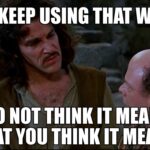 Recap
Recap
Jim Sarantinos had asked: “Can you tell me how to format montage sequences?”
In Part 1 of this article, I started off my response by listing the order of operations I usually follow for exploring any type of script formatting issue:
1. Search JohnAugust.com for tips
2. Refer to Christopher Riley’s book, The Hollywood Standard
3. Refer to David Trottier’s book, The Screenwriter’s Bible
4. Consult my library of scripts and Scott Myers’
GoIntoTheStory.com
5. Use what makes sense to me. Throw out the rest.
We covered number 1 last time, with John August’s recommendation for formatting single-location montages.
But what if you have multiple locations, or different times (i.e. DAY and NIGHT)?
Formatting Guides
There are two industry-standard script formatting guides that address both these scenarios quite nicely.
The first is Christopher Riley’s, The Hollywood Standard. After all, it’s the book that finally convinced John August (at least for the time being) that he didn’t need to write about screenwriting format any longer.
The second is David Trottier’s, The Screenwriter’s Bible. It’s a little older, but also provides numerous examples to help you understand the points being made.
MONTAGE vs. SERIES OF SHOTS
A quick word about these two devices. Both guides will tell you that MONTAGE and SERIES OF SHOTS can be used interchangeably, however MONTAGE is much more commonly used.
In general, a MONTAGE is used for those longer sequences that you typically see set to music, and usually focuses on a theme or concept (e.g. JACK AND DIANE ENJOY THE BEACH).
A SERIES OF SHOTS is typically comprised of quick, short shots to rapidly convey a story segment (e.g. TIMMY SNEAKS OUTSIDE). So if it’s helpful, think MONTAGE (MUSIC) / SERIES OF SHOTS (SHORT STORY). And when in doubt, just use MONTAGE.
But honestly, either way, no one’s likely to throw your script out just because you used MONTAGE instead of SERIES OF SHOTS or vice versa. While some purists may disagree, there are no hard and fast, right and wrong rules here.
FORMATTING EXAMPLES
Remember, when considering all of these examples, we need to heed John August’s words:
My advice is to pick the simplest version that gets the point across. You may find that you’re using two or three different formats in a single script, depending on the needs of each sequence.1
So I’ll try to move from basic to more complex…
Example 1: Basic
MONTAGE
Jack and Diane stroll arm-in-arm along the sidewalk. They see a contorted mannequin, its head faces the wrong way. Diane winces. Jack laughs.
They share a plate of spaghetti at a patio restaurant. Diane dangles a single noodle from her lips, wants Jack to play along. He grabs the other end of the noodle in his mouth. Slurps it up in one quick motion. Cheers like he’s just scored a touchdown.
An old romantic film plays at a theater. Diane rolls her eyes at the screen. Turns to Jack. He stares, riveted, teary eyed. She smiles.
END MONTAGE
Notes:
1) If the montage is short enough (as above), you can simply use a new scene heading to denote that it has ended (instead of END MONTAGE).
If you feel like adding a little descriptor of what the montage is all about, that’s common/acceptable as well. For example, the above montage header I could have written something like: “MONTAGE – JACK AND DIANE’S FIRST DATE”
Example 2: Indented
Here, double lines are used.
MONTAGE
-- Jack and Diane stroll arm-in-arm along the sidewalk. They see a contorted mannequin, its head faces the wrong way. Diane winces. Jack laughs.
-- They share a plate of spaghetti at a patio restaurant. Diane dangles a single noodle from her lips, wants Jack to play along. He grabs the other end of the noodle in his mouth. Slurps it up in one quick motion. Cheers like he’s just scored a touchdown.
-- An old romantic film plays at a theater. Diane rolls her eyes at the screen. Turns to Jack. He stares, riveted, teary eyed. She smiles.
You can also have some fun with this method and make sure the secondary lines match the indent of the first line:
MONTAGE
-- Jack and Diane stroll arm-in-arm along the sidewalk. They see a contorted mannequin, its head faces the wrong way. Diane winces. Jack laughs.
-- They share a plate of spaghetti at a patio restaurant. Diane dangles a single noodle from her lips, wants Jack to play along. He grabs the other end of the noodle in his mouth. Slurps it up in one quick motion. Cheers like he's just scored a touchdown.
-- An old romantic film plays at a theater. Diane rolls her eyes at the screen. Turns to Jack. He stares, riveted, teary eyed. She smiles.
Example 3: Scene Headings
Some production companies and studios like you to list a location for each shot…
MONTAGE
-- Sidewalk – Jack and Diane stroll arm-in-arm . They see a contorted mannequin, its head faces the wrong way. Diane winces. Jack laughs.
-- Patio restaurant – They share a plate of spaghetti. Diane dangles a single noodle from her lips, wants Jack to play along. He grabs the other end of the noodle in his mouth. Slurps it up in one quick motion. Cheers like he’s just scored a touchdown.
-- Old theater – Diane rolls her eyes at the romance on screen. Turns to Jack. He stares, riveted, teary eyed. She smiles.
See how I had to change up the descriptions a little to avoid the redundancy of the location?
If you’re already adding in locations, and you want to be sure to indicate the shift in times, you could also do the following:
MONTAGE
-- EXT. SIDEWALK – DAY -- Jack and Diane stroll arm-in-arm. They see a contorted mannequin, its head faces the wrong way. Diane winces. Jack laughs.
-- EXT. PATIO RESTAURANT – NIGHT -- They share a plate of spaghetti. Diane dangles a single noodle from her lips, wants Jack to play along. He grabs the other end of the noodle in his mouth. Slurps it up in one quick motion. Cheers like he’s just scored a touchdown.
-- EXT. OLD THEATER – NIGHT -- Diane rolls her eyes at the romance on screen. Turns to Jack. He stares, riveted, teary eyed. She smiles.
END MONTAGE
Again, here I changed things slightly, adding a double dash after the more official scene heading. I also used the END MONTAGE just to avoid any confusion as to where the montage ended (because full scene headings were used inside the montage).
Example 4: Series of Shots
SERIES OF SHOTS – TIMMY SNEAKS OUT
Timmy’s eyes open. He yanks his bed covers off, already dressed with sweats and shoes.
Gentle footsteps, as he makes his way down the hallway.
He searches the fridge. Stuffs his face with cookies. Looks around.
At the front door. He pulls on a woolen facemask. Looks like a midget bank robber.
He tiptoes outside. Turns back to look at the house. Trips, CRASHES over two bags filled with CANS.
All the lights in the house turn on. His mom peaks her head out the window.
Remember, a SERIES OF SHOTS typically tells a short contained story segment. As with MONTAGE I could have left off the “TIMMY SNEAKS OUT” part. It just depends on the flavor of your script and if you want to use the heading option for clarity.
An alternate method is to use alphabetized letters to delineate the shots:
SERIES OF SHOTS - TIMMY SNEAKS OUT
A) Timmy's eyes open. He yanks his bed covers off, already dressed with sweats and shoes.
B) Gentle footsteps, as he makes his way down the hallway.
C) He searches the fridge. Stuffs his face with cookies. Looks around.
D) At the front door. He pulls on a woolen facemask. Looks like a midget bank robber.
E) He tiptoes outside. Turns back to look at the house. Trips, CRASHES over two bags filled with CANS.
F) All the lights in the house turn on. His mom peaks her head out the window.
Of course, you could also call it a MONTAGE and use the lettered approach as well.
MONTAGE - THE FIRST DATE
A) EXT. SIDEWALK - DAY Jack and Diane stroll arm-in-arm. They see a contorted mannequin, its head faces the wrong way. Diane winces. Jack laughs.
B) EXT. PATIO RESTAURANT - NIGHT They share a plate of spaghetti. Diane dangles a single noodle from her lips, wants Jack to play along. He grabs the other end of the noodle in his mouth. Slurps it up in one quick motion. Cheers like he's just scored a touchdown.
C) EXT. OLD THEATER - NIGHT Diane rolls her eyes at the romance on screen. Turns to Jack. He stares, riveted, teary eyed. She smiles.
And that’s enough for montages for another day! Just save this series so you’ll have it to refer to when you need it.
In the conclusion of this thrilling three part saga, we’ll consult my script library and check out Scott Myers’ web site gointothestory.com.
We will need it for handling some tricky montages that include dialogue and span multiple days or years. There will also be some formatting surprises from well known montages used in films.
Until next time… I’ll leave you with the video that taught me everything I know about montages. 🙂
- JohnAugust.com, Formatting a Montage Sequence ↩





Thanks. As with everything, there is no best way. I tend to go with option three (subheadings or sluglines) to make the read easier. Too many additional scene headings or letters hamstring the read. Also leave some room for the director.. eg a scene in a theme park, I use:
TACO STAND
He stuffs two tacos down his throat at the same time.
FERRIS WHEEL
He clasps his stomach as he whirls round and round.
RESTROOM
He vomits his tacos into the bowl.
The main scene is always:
INT. THEME PARK – DAY
This technique is also useful when describing different areas in a house such as kitchen, bedroom, dining room.
Don’t forget, one of the joys of using a montage is the ability to short-hand things and save space. So you shouldn’t feel the need to include secondary headings — especially if you’ve already set things up (above the MONTAGE) with a master scene heading. Maybe you can just use a variation of the first example instead.
Greetings
Thanks Trevor for the great example.
It’s the first time I’ve seen all of these examples together and explained so simply.
I don’t know which ones are favored in Hollywood,
but I prefer the first example just because it’s the least intrusive and clearest one in the bunch.
The lettering and numbering stops me from breezing through the story.
John Bradt
Your instincts are right on John. In a spec script especially, simple is better. Thanks for the feedback!
I had planned a Part 3 for this series, but haven’t gotten around to it. Someday soon…
Can you give an example of a Montage or Series of shots scored to music. I want to be CLEAR, SIMPLE & save space.
I need the scene to transition from place to place with background music. I’m showing a song ‘voiced over’ via Radio while playing in the background during the main character’s Radio interview. And different peoples (small town) reactions to the main character’s Radio interview with the background music.
Hi Doug,
The good news is it’s expected that montages will be to music, so I wouldn’t bother specifying any music. It’s just a given.
So just choose a format that works for you.
Hi Doug, I’m loving parts 1 and 2 on Montages, but can’t find Part 3. Did you write one? Thanks, Dan
Hi Dan, great to hear you enjoyed this series. I could have sworn I had written a third part, but I can’t find it. If you have any remaining questions, please let me know. Oh, and who’s Doug?
Trevor
Hi Trevor, I’m Doug. I asked a question about montages. You answered it. So, I believe that Dan got you & I confused. I did not put out my montage for consumption. But, I can put it out there so you can see if I learned from your Montage advice. Let me know if you want to see my Montage. May be a learning experience for other’s also.
Ah yes, that makes sense. Thanks, Doug. I really should have read back through the thread. 🙂
And yes, I’d love to see what you came up with for your montage. It would indeed be very instructive.
Thank you Trevor, apologies. Thank you Doug, well spotted. -Dan
MONTAGE
— Opera House Alleyway – Lettie, Lee and Carr sit in Carr’s
carriage. Carr conjures in grand gestures. He touches
Lettie’s belly. Carr puts Lee’s hands on Lettie’s belly.
Lettie is crying. Lee smiles proudly.
— Opera House Center Stage – Smiley Hanlon (Dorothy) sings
in front of a translucent screen: “Somewhere Over The
Rainbow.” Behind the opalescent screen, we see silhouettes of
coal miner dwarfs’ swing picks into a black (coal) abyss.
— Opera House Audience – The hardened faces in the audience
smooth into relaxed awe.
— Back Stage – Victor and Belch open the flying monkeys’ (attached wings)
cage doors. We see a peanut trail to Dorothy.
— Center Stage – Dorothy stands beneath the
rainbow. The opalescent screen begins to lift up.
Spotlights reflect brilliant rhinestone rainbow
colors that shimmer and dance around Dorothy.
–There is standing-room-only in the gilded 3 tiered arena.
Flying monkeys’ spring through the air and onto and around
Dorothy. A monkey lands on Dorothy’s head. The flying monkey grabs
Dorothy’s wig. The monkey jumps into the audience with the
pigtail wig in hand.
–Back Stage – Victor picks up a black Coal Hod
bucket full of powdered coal soot. He walks towards
Dorothy at center stage. Along the way, he kicks monkey that are sitting on
the stage eating peanuts. The monkeys jump and fly into the
audience.
— Center Stage – Victor throws the coal soot into Dorothy’s
face like stoking powdered coal into a furnace.
— Audience – The monkeys pounce into the audience. Floormodel
industrial fans quickly blow soot through the Opera
House arena. The audience patrons begin to run towards the
exits.
— Opera House Alleyway – Lettie and Lee stand alone in the
alleyway. A blackened Smiley runs past them. Lettie screams.
Lee gives chase. He and Lettie are pushed down and trampled
by audience patrons running towards Main Street.
MATCH CUT TO:
SUPER: “17 YEARS LATER”
— NYC – 81ST STREET – MADISON AVENUE – FRANK E. CAMPBELL
FUNERAL HOME –
PERMELIA CORN (aka., Smiley Hanlon), EDITH
(Permelia’s biological mother) and Lee stand in front of Judy Garland’s
glass enclosed coffin. They peer into the coffin. Edith wraps
her arm around her anatomically correct daughter, Permelia
Corn. She pulls her daughter to her and kisses her forehead.
— NYC – CHRISTOPHER STREET – “Stonewall Bar and Inn,” 1969.
The just deceased, Judy Garland (Permelia Corn) sings from
center stage. She sings, “Somewhere Over The Rainbow.” Disco
ball mirror squares reflect colored hues off the massive b.g.
rhinestone, rainbow-colored arch.
–Bright, white warning bar lights flicker on and off three
times. The New York City Sixth Precinct along with three BATF
(Bureau of Alcohol, Tobacco and Firearms) burst through the
bar doors.
END MONTAGE
Hi Doug. Well done! Thanks for sharing.
A couple notes:
— Put the locations in UPPERCASE.
– Make sure each montage item has a location (for consistency). Example:
— ARENA – It’s standing-room-only in the gilded, three-tiered theater seats.
— Make sure there’s a space after each double hyphen.
– Typo. Should be: “Along the way, he kicks monkeys that are sitting on the stage eating peanuts.”
— Your SUPER should always come after the first action line paragraph:
— NYC – 81ST STREET – MADISON AVENUE – FRANK E. CAMPBELL FUNERAL HOME – PERMELIA CORN (aka., Smiley Hanlon), EDITH (Permelia’s biological mother) and Lee stand in front of Judy Garland’s glass enclosed coffin.
SUPER: “17 YEARS LATER”
They peer into the coffin. Edith wraps
her arm around her anatomically correct daughter, Permelia Corn.
—-
Great work!
Trevor.
Thank you very much for your teaching expertise.
I look forward to completing the first draft & retaining your services.
Doug